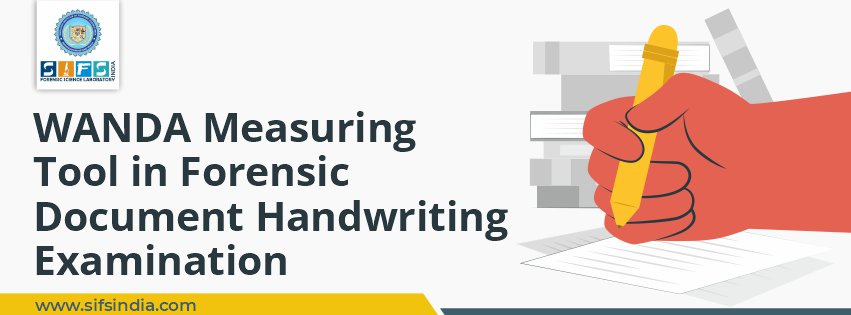A desktop workbench called the WANDA system assists the user during the entire process of measuring distinguishing characteristics in handwritten papers.
Using plug-ins, XML, and client/server modularity, a system that is simple to maintain, accessible, and highly customizable was developed.
The WAM is WANDA's tool for forensic document handwriting examination and interactively measures handwriting characteristics. The WAM is based on findings from a study comparing Script and FISH, two writer identification techniques.
It includes a new allograph measurement in addition to nine measurements that are exactly the same as those in FISH. Additionally, its new user-elegant interface's design speeds the working process and lessens the challenging learning curve.
By contrasting the derived features with measurements taken using FISH by forensic professionals, the accuracy of the WAM was evaluated.
By contrasting handwriting on paper with equivalent scanned offline photos, this was further confirmed. Both validations demonstrate that the WAM functions properly.
The WAM is simple to use and produces measurement values that are equal to those generated by FISH, according to first usability testing with expert and novice users.
Forensic Information System on Handwriting (FISH)
A forensic handwriting specialist can evaluate a piece of handwriting's characteristics using the FISH system, which is a handwriting analysis and writer identification tool.
In order to determine the best matches, the handwriting that has been marked with the measurable attributes will be compared to previously gathered and measured samples of handwriting.
Although FISH provides outstanding results for writer identification, its user interface should be made better. In addition, a technological upgrade was required to increase its portability and simplicity of maintenance.
Working of WANDA
There will be several procedures to follow before the WAM is employed when a user has some handwriting that has to be analysed and identified.
The user is going to scan the handwriting first. This scan will be kept in the WANDA database and used as the foundation for all later actions.
Now, the user can access the scan from the database. Now that the image has been scanned, the user can choose an "region of interest" (ROI). An ROI is the area of the user's handwriting that is currently being worked on
The remaining components of the WANDA workbench, including the WAM, can be used when an ROI is chosen. But before using the WAM, it is wise to employ the WANDA image reprocessing tool.
Two windows make up the WAM interface: the main window and the measure window. An overview of each measurement that has been made on the current ROI may be found in the WAM's main window.
For the user's convenience and to avoid over cluttering the image, the measures are colour-coded according to type. A table with the measurement data is displayed and is accessible via the menu.
This information, which is computed for each measurement type, includes the number of measurements made in this ROI, their average value, and their standard deviation.
The user must choose a character from the drop-down list to measure a feature on in order to do so.
A character that resembles the one chosen by the user can be started being measured.
The user is assisted during this operation by the instruction window, a novel WAM interface feature that walks the user step-by-step through the measuring process.
Without obstructing specialists in any way, this enables new users to begin measuring straight immediately. The three control buttons, which can be used to accept and complete the present measurement, and, which can be used to stop this kind of evaluation in progress.
Future Perception in Documents Examination
There are numerous suggestions for how to expand and use the WANDA Workbench.
First and foremost, we plan to use it for forensic casework. In the areas of forensic handwriting and signature analysis, as well as writer identification, we see tremendous potential for study and development.
Advanced software modules, in particular, bring new objective testing processes that are not available in existing computer systems, such as computer-based signature validation and stroke morphology analysis.
The use of architecture enables the merging and exchange of gathered handwritten data, subject-specific knowledge, and implemented software procedures.
According to assessments by forensic handwriting specialists and to new requirements created by impending investigation and analysis aims, we anticipate modifications and extensions of the data model and its associated modelling language Wanda XML in the near future.
It is acknowledged that achieving those goals will also necessitate the incorporation of additional client and server plug-ins.
Additionally, the distributed client/server architecture enables the combining and sharing of gathered handwriting data, domain-specific knowledge, and developed software procedures.
Conclusion
A technological and practical upgrade to the FISH writer identification system is WANDA.
Modern technologies are incorporated into WANDA, creating an innovative, adaptable, and open system. As a result, it is simple to extend, transport, and maintain.
The WANDA component, the WAM tool, improves the interactive feature measurements. A redesigned user interface for the WAM uses text and colour cues to provide the user a clear and practical overview of the tool's capabilities and state right now.
Additionally, it offers a new allograph measurement as a proof of concept for recognition-based metrics.
The WAM validation demonstrates that the system produces accurate results and that the interface is well-designed and useable by both professionals and beginners.

 October 16, 2022 - BY SIFS India
October 16, 2022 - BY SIFS India